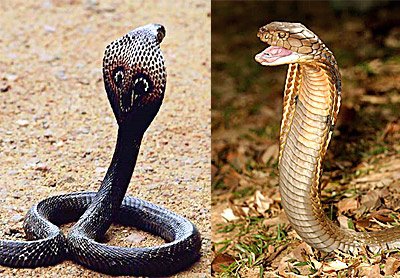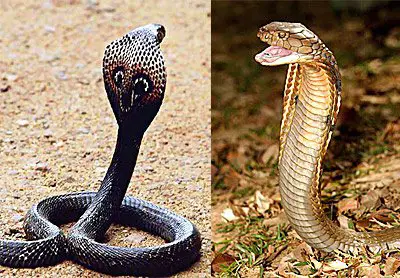King cobras are among the most iconic and feared snakes in the world. With their impressive size and venomous bite, they strike fear into the hearts of many. However, despite their name and appearance, these snakes are not actually true cobras.
So why is the king cobra not a true cobra? The answer lies in its physical and behavioral characteristics. In this article, we will explore the fascinating world of these majestic snakes and discover what sets them apart from their cobra cousins. Join us as we delve into the world of the king cobra and learn why it is truly one of a kind.
The King Cobra may look like a true cobra, but it actually belongs to a different genus. Unlike true cobras, the King Cobra has a single anal plate instead of paired plates and has a different arrangement of teeth. Additionally, the King Cobra is the longest venomous snake in the world and has a unique feeding behavior.

Why is the King Cobra Not a True Cobra?
King cobras are some of the most fascinating and feared snakes in the world. They are known for their impressive size, deadly venom, and distinctive hood. However, despite their name and resemblance to other cobras, king cobras are not true cobras. In fact, they belong to a different genus altogether. Here’s why.
Classification
King cobras belong to the genus Ophiophagus, which means “snake eater” in Greek. This is in contrast to true cobras, which belong to the genus Naja. While both Ophiophagus and Naja are part of the family Elapidae, they have distinct differences in terms of morphology, behavior, and venom.
King cobras are the longest venomous snakes in the world, with some individuals reaching lengths of up to 18 feet. They are native to Southeast Asia, where they inhabit forests, swamps, and agricultural areas. They are known for their distinctive hood, which they can flare when threatened, and their potent venom, which can kill a human in just a few hours.
Morphology
One of the main differences between king cobras and true cobras is their morphology. King cobras have a much larger head and thicker body than most true cobras. They also have longer fangs and a more powerful venom delivery system. In addition, king cobras have distinctive black and white bands on their body, while true cobras typically have a solid color.
Behavior
King cobras are also different from true cobras in terms of their behavior. While both species are highly venomous and can be aggressive when threatened, king cobras are known for their unique hunting strategy. They are known to feed on other snakes, including venomous species such as kraits and other cobras. They are also capable of climbing trees and swimming, which gives them an advantage over many other predators.
Venom
The venom of king cobras is another key difference between them and true cobras. King cobra venom is highly potent and can cause respiratory failure, paralysis, and death in humans. However, unlike many true cobras, king cobras do not typically spit their venom. Instead, they inject it directly into their prey using their long fangs.
Benefits of King Cobras
Despite their fearsome reputation, king cobras play an important role in their ecosystem. As top predators, they help to control populations of other snakes and small mammals, which helps to maintain a healthy balance in the food chain. In addition, their venom has been used in traditional medicine in some cultures to treat a variety of ailments, including pain and inflammation.
King Cobras vs. True Cobras
While king cobras and true cobras share some similarities, such as their venomous bite and distinctive appearance, they are fundamentally different in many ways. King cobras are larger, more powerful, and more aggressive than most true cobras, and they have a unique hunting strategy that sets them apart from other snakes. In addition, their venom is more potent and delivered differently than that of true cobras.
In Conclusion
King cobras may be called “cobras,” but they are not true cobras. They belong to a different genus altogether and have distinct differences in terms of morphology, behavior, and venom. Despite their reputation as deadly predators, they play an important role in their ecosystem and have been used in traditional medicine for centuries.
Frequently Asked Questions
King cobras are fascinating creatures that are often mistaken for true cobras. However, they have some distinct differences that set them apart. Here are some commonly asked questions about why the king cobra is not a true cobra.
What is a true cobra?
A true cobra is a member of the Naja genus, which includes over 20 species of venomous snakes. They are known for their iconic hoods and their ability to spit venom. True cobras are found in Africa and Asia, and they are closely related to other venomous snakes like mambas and cobras.
King cobras, on the other hand, are the only species in their genus, Ophiophagus. They are found in Southeast Asia and are known for their size and strength. While they share some similarities with true cobras, they have some distinct differences that make them a unique species.
What are the differences between a king cobra and a true cobra?
One of the main differences between king cobras and true cobras is their size. King cobras are the longest venomous snakes in the world, reaching lengths of up to 18 feet. True cobras, on the other hand, are much smaller, usually measuring between 3 and 6 feet long.
Another difference is their behavior. King cobras are known for their aggressive nature and their ability to rear up and stand their ground when threatened. True cobras are more likely to retreat when confronted.
Why is the king cobra not classified as a true cobra?
The king cobra is not classified as a true cobra because it has some distinct physical and behavioral differences. One of the most notable differences is the presence of a single pair of elongated teeth in the front of the king cobra’s mouth. These teeth are not found in true cobras.
Additionally, the king cobra’s diet is different from that of true cobras. While true cobras primarily eat other snakes, King cobras have a more diverse diet that includes lizards, rodents, and other small animals.
Is the king cobra more dangerous than a true cobra?
Both king cobras and true cobras are highly venomous and should be treated with caution. However, the king cobra’s venom is more potent than that of most true cobras. Additionally, the king cobra’s size and strength make it a more formidable opponent. If threatened, a king cobra is more likely to stand its ground and attack, while a true cobra is more likely to retreat.
That being said, it’s important to remember that both types of snakes are dangerous and should be treated with respect and caution. If you encounter a king cobra or a true cobra in the wild, it’s best to keep your distance and seek professional help if necessary.
Are king cobras endangered?
Yes, king cobras are listed as a vulnerable species by the International Union for Conservation of Nature (IUCN). They are threatened by habitat loss, hunting, and the illegal wildlife trade. In some parts of their range, king cobras are hunted for their meat, skin, and other body parts, which are used in traditional medicine and other cultural practices. Conservation efforts are underway to protect king cobras and their habitats, but more work needs to be done to ensure their survival.
Deadly venomous King cobra is not a true cobra!
In conclusion, the King Cobra may share many similarities with the true cobra species, but there are also significant differences that set it apart. Its size, venom potency, and behavior are just some of the factors that make it unique. Despite not being a true cobra, the King Cobra is still a fascinating and awe-inspiring creature that deserves our respect and admiration.
Furthermore, understanding the differences between the King Cobra and true cobras is essential for researchers and conservationists who aim to protect these species. By identifying the distinct characteristics of each species and studying their behaviors, we can develop better conservation strategies to ensure their survival.
In the end, whether it’s a true cobra or not, the King Cobra remains a remarkable creature that has captured the fascination of people around the world for centuries. Its beauty, power, and grace serve as a reminder of the incredible diversity and wonder of the natural world we live in.


